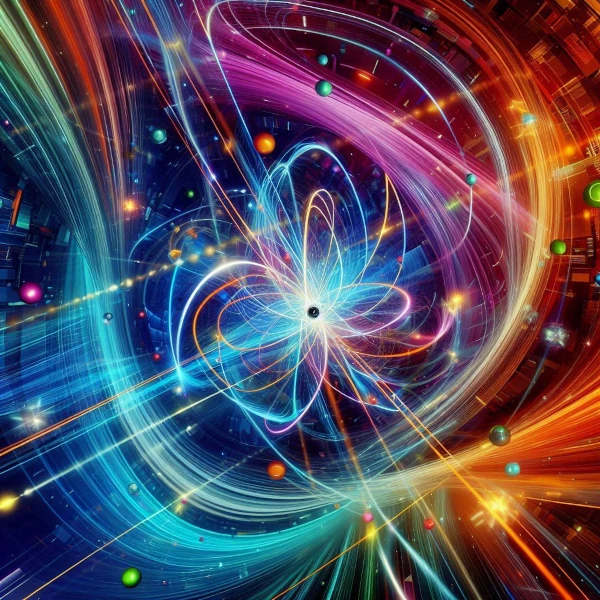
Image description: Artistic visualization of unstable particle interactions. Image source: astronoo.com
Each particle contains enormous energy, governed by subtle and complex mechanisms, studied within the fascinating realm of particle physics.
Quarks and leptons are the elementary particles that make up all the ordinary matter we know, while bosons are the mediators of the fundamental forces of nature. These quantum constituents are described by the Standard Model of elementary particles, confirmed by experimental discoveries such as the top quark (1995), the tau neutrino (2000), and the Higgs boson (2012).
Protons and neutrons are composite particles, non-elementary, made up of a complex assembly of quarks held together by gluons. These gluons, carriers of the strong nuclear force, transmit a property called color charge, hence the informal name "color force."
The pentaquark is a composite particle, but its structure is much more complex than that of a proton. Pentaquarks are exotic subatomic particles composed of five quarks. According to the Standard Model of particle physics, quarks are the fundamental building blocks of matter, typically combined in groups of two or three to form mesons (pions or kaons) and baryons (protons or neutrons).
A pentaquark consists of four quarks ($q$) and one antiquark ($\bar{q}$), which can be symbolically written as $(qqqq\bar{q})$. This structure allows for a great diversity of possible combinations, making their study particularly complex. In fact, a pentaquark can be composed of different combinations of quarks (up, down, strange, charm, bottom, top) and antiquarks. Each combination will lead to a pentaquark with a different mass. These states are formed by strong interactions, described by the theory of quantum chromodynamics (QCD).
Unlike the proton, which is composed of two up quarks ($u$) and one down quark ($d$) and is stable (lasting 1030 years), pentaquarks are extremely unstable and decay rapidly into other particles, such as unstable mesons (pions or kaons) or more stable baryons (protons or neutrons). Their lifetime is comparable to that of strongly interacting particles produced by the strong force, that is, between 10-23 to 10-20 seconds.
It is impossible to isolate a single quark because the strong interaction, which binds them, becomes increasingly intense as quarks move farther apart. This phenomenon, known as "quark confinement," implies that the force acts like an elastic bond, keeping the quarks together. In contrast, when quarks are very close to each other, the strong interaction weakens, giving rise to a property called "asymptotic freedom." Asymptotic freedom describes the fact that, at very short distances or very high energies, quarks interact weakly and behave almost like free particles, a unique property of the strong interaction. This characteristic arises from the color charge, specific to particles subject to the strong interaction.
Pentaquarks are detected indirectly in high-energy physics experiments (such as at the LHCb at CERN) through the products of their decay. The signatures of their rapid decay allow for an estimation of their lifetime.
Pentaquarks were experimentally detected in 2015. This discovery confirmed the existence of exotic forms of matter that had been theoretically predicted since the 1960s. These particles offer a unique window to study the fundamental force that binds quarks together.
Describing a pentaquark (four quarks and one antiquark) as a subtle combination of a baryon (three quarks) and a meson (one quark and one antiquark) is a partial and plausible description, but it corresponds to a specific hypothesis (molecular state). Other configurations, such as the compact state, are also considered. Ongoing research aims to precisely determine the nature of these exotic hadrons.